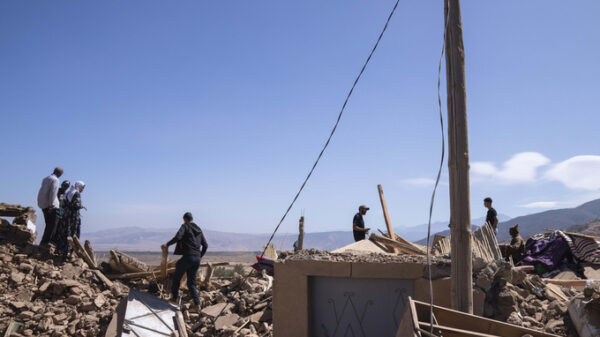President Joe Biden speaks about the bipartisan infrastructure bill from the East Room of the White House in Washington, Tuesday, Aug. 10, 2021. With a robust vote after weeks of fits and starts, the Senate approved a $1 trillion bipartisan infrastructure plan on Tuesday, a rare coalition of Democrats and Republicans joining to overcome skeptics and deliver a cornerstone of President Joe Biden’s agenda. (AP Photo/Susan Walsh)
WASHINGTON (AP) — When President Joe Biden first announced the framework he’d reached with a bipartisan group of senators for a big infrastructure bill, he said it meant more than building roads and bridges.
Agreement, he said two months ago, would send a signal “to ourselves and to the world that American democracy can deliver.”
The senators who led the legislation to passage Tuesday agreed.
“We all knew that, quite honestly, that the world was watching,” said Sen. Jon Tester, D-Mont.
Approved on an overwhelming 69-30 vote, the nearly $1 trillion package would boost federal spending for major improvements of roads, bridges, internet access and other public works in communities from coast to coast. The bill goes next to the House.
What should have been routine, a task Biden recalled as “probably the least difficult thing to do” when he was a senator, became an exercise in showing how damaged the legislative process has become in partisan Washington and how a president and core group of senators were determined to try to fix it.
Powering past skeptics, the five Democratic and five Republican senators who negotiated the deal were interested in Biden’s call to “build back better” after so many failed attempts at an infrastructure overhaul. But they also wanted to build back the confidence of Americans and the world that the U.S. government could tackle big problems.
“We really realized that this was going to be important for the country and I think it’s important for the institution,” Sen. Lisa Murkowski, R-Alaska, said recently after a long day at the Capitol. “I’m really worried that everybody believes that we’re as dysfunctional as we appear to be, and so prove otherwise, it’s kind of important.”
Since Biden took office, small groups of senators had been talking and meeting quietly on their own and sometimes with the White House, searching for ways to reach across the aisle on a range of issue — among them the minimum wage, immigration and infrastructure.
Many were alumni of the bipartisan coalition that stitched together a year-end COVID-19 relief package and saw an opportunity for compromise in the evenly split 50-50 Senate, where typically 60 votes are needed to advance any legislation over an opposing filibuster.
Democratic Sen. Joe Manchin of West Virginia and Murkowski held private lunches with senators in a committee room. Others hosted dinners at their homes.
These were the early days of the Biden administration, not long after rioters stormed the Capitol on Jan. 6 in the deadly insurrection that shattered civic norms and left a deepening unease among lawmakers.
Biden had delivered an inaugural address with a call for unity after the turbulent 2020 election, and some of the Republican senators had joined in voting to convict Donald Trump of inciting the insurrection to upend Biden’s presidency. The former president was ultimately acquitted in his impeachment trial.
Republican Sen. Susan Collins of Maine said those issues, along with the history of failed efforts to invest in infrastructure, were on her mind as she joined the effort.
“It was a major motivation for me,” Collins said, “to demonstrate to the American people that we could overcome the hyper-partisanship in Washington on a very important issue that administrations of both parties have been calling for, for the past 20 years.”
Biden had been in talks with another bipartisan coalition led by Manchin and fellow West Virginia Sen. Shelley Moore Capito, a Republican, but once that effort collapsed, he reached out to Sen. Kyrsten Sinema, the Democratic senator from Arizona.
A newer lawmaker, better known for her purple pandemic wig and chatting on the GOP side of the Senate aisle, Sinema made no secret of her reluctance to embrace Biden’s big infrastructure plan, which initially topped $4 trillion.
She had already been working behind the scenes with Sen. Rob Portman, R-Ohio, and others in what another member of the group, Sen. Mitt Romney, R-Utah, described as a “backburner” coalition. They became the group of 10.
The White House sprang into action, eventually engaging in hundreds of meetings and phones calls with lawmakers of both parties in the House and Senate. The administration coordinated visits by members of the president’s “Jobs Cabinet,” and counselor Steve Ricchetti became a fixture on Capitol Hill.
“If there was a special sauce it was relationships,” Transportation Secretary Pete Buttigieg said in an interview.
The president was highly engaged, briefed multiple times a day about the talks and often directing the strategy. He worked the phones.
Biden “was able to establish a tone,“ Buttigieg said.
Trump, like previous presidents, had sought to assemble an infrastructure package during his time at the White House, but often sent mixed signals to negotiators and frustrating lawmakers by threatening to withdraw support from items to which he had previously committed. But senators said it was clear when Biden sent his top aides to talk with the senators, “they had the president’s proxy,” Collins said. “That made a difference.”
As final weeks of negotiations moved to Portman’s basement office at the Capitol, the group popped bottles of wine and ordered pizza for the difficult late-night sessions. Tempers flared, frustration mounted and exhaustion set in.
“We didn’t fully throw pizza,” said Democratic Sen. Mark Warner of Virginia. But there were “lots of time when people do get mad with each other.”
The whole deal almost collapsed the June day it was first announced when Biden suggested at a news conference he would not sign it into law without also having his broader $3.5 trillion package alongside it, infuriating the Republicans who staunchly oppose that bill.
Collins was waiting at the airport for a flight back home to Maine when she read the headline and immediately called Biden’s top staff for an explanation.
Tester, sitting on his tractor at home in Montana, was dumbfounded.
Biden sent a lengthy statement two days later assuring the group that he would fight for both bills and putting negotiations back on track.
After Tuesday’s overwhelming vote in the Senate, the president called each of the 10 senators personally, reaching Sinema in the Senate cloakroom.
“They sent me a note. It said, ‘Biden on three for you.’ I literally said, ‘I don’t know what that means,’” Sinema told The Associated Press.
“He said congratulations and we spent some time talking about how important this victory is, not just for the work we’re doing on infrastructure but also to demonstrate that bipartisanship is still alive and our Congress can function,” she said.
“And then we talked about continuing to work together to get this bill across the finish line and onto his desk.”
___
Associated Press writer J.J. Cooper in Phoenix contributed to this report.
Source: https://apnews.com/article/joe-biden-business-capitol-siege-93ba70c13edd7790ca5e23b53cd70db1





























